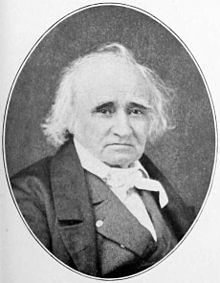Henry Marie Brackenridge
| Henry Marie Brackenridge | |
|---|---|
 |
|
| Member of the U.S. House of Representatives from Pennsylvania's 22nd district |
|
|
In office October 13, 1840 – March 3, 1841 |
|
| Preceded by | Richard Biddle |
| Succeeded by | William W. Irwin |
| Personal details | |
| Born | May 11, 1786 Pittsburgh, Pennsylvania |
| Died | January 18, 1871 (aged 84) |
| Political party | Whig |
Henry Marie Brackenridge (1786–1871) was an American writer, lawyer, judge, superintendent and first federal forester) and Congressman from Pennsylvania.
He was born the son of the writer and judge Hugh Henry Brackenridge in Pittsburgh, Pennsylvania on May 11, 1786. Educated by his father and private tutors, he attended a French academy at St. Genevieve, Louisiana (now Missouri). He studied law and was admitted to the Pennsylvania bar in 1806, then practiced in Somerset, Pennsylvania.
He moved to St. Louis, Missouri, where he was a lawyer and journalist. In 1811 Brackenridge was the first recorded tourist to present-day South Dakota, hosted by fur trader Manuel Lisa. Henry was appointed deputy attorney general of the Territory of Orleans (Louisiana), and district judge of Louisiana in 1812.
He played an intelligence role during the War of 1812, and in 1814 published a history of the war. In 1817 he was appointed secretary of a mission to South America. He was elected a member of the American Antiquarian Society in 1818. Brackenridge in 1821 entered the diplomatic service of General Andrew Jackson, who was the new commissioner of Florida. Through Jackson's influence, he served as U.S. judge for the western district of Florida 1821–32.
When President John Quincy Adams established the Naval Live Oak Area, (currently identified as Naval Live Oak Reservation) on January 18, 1829; Superintendent Henry Marie Brackenridge lived on the property and experimented with cultivating the live oak tree for shipbuilding. He was perhaps our country's first federal forester.
Brackenridge returned to Pennsylvania in 1832 and became owner of a large tract of land upon which he founded the town of Tarentum, 22 miles northeast of Pittsburgh on the Allegheny River. The adjacent Allegheny County borough of Brackenridge is named for him.
...
Wikipedia
